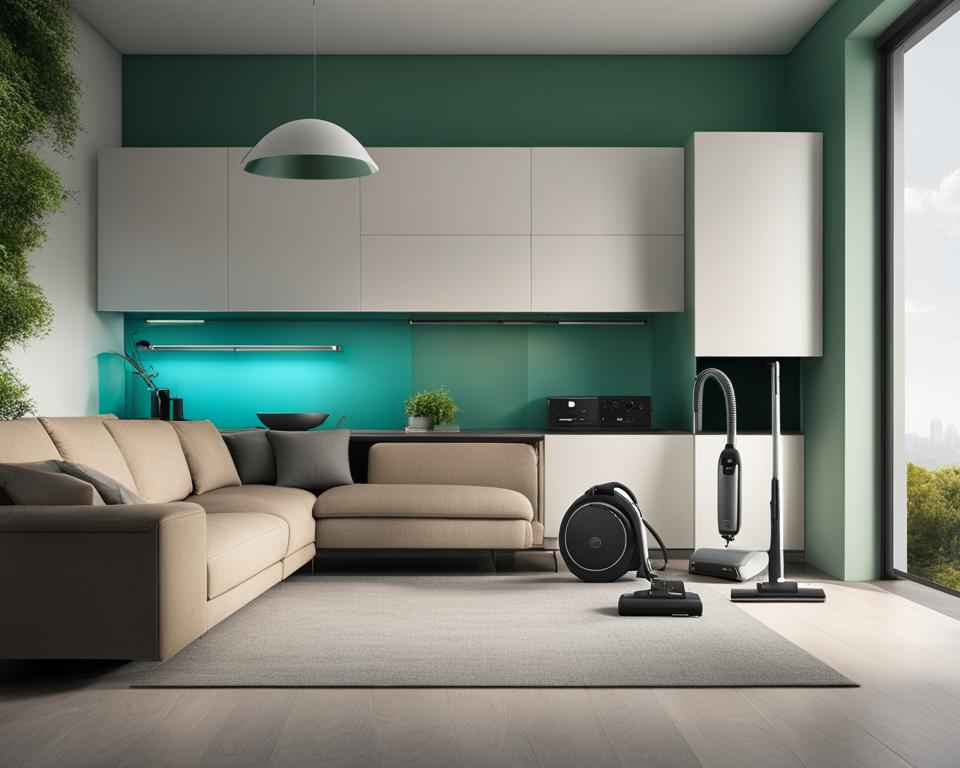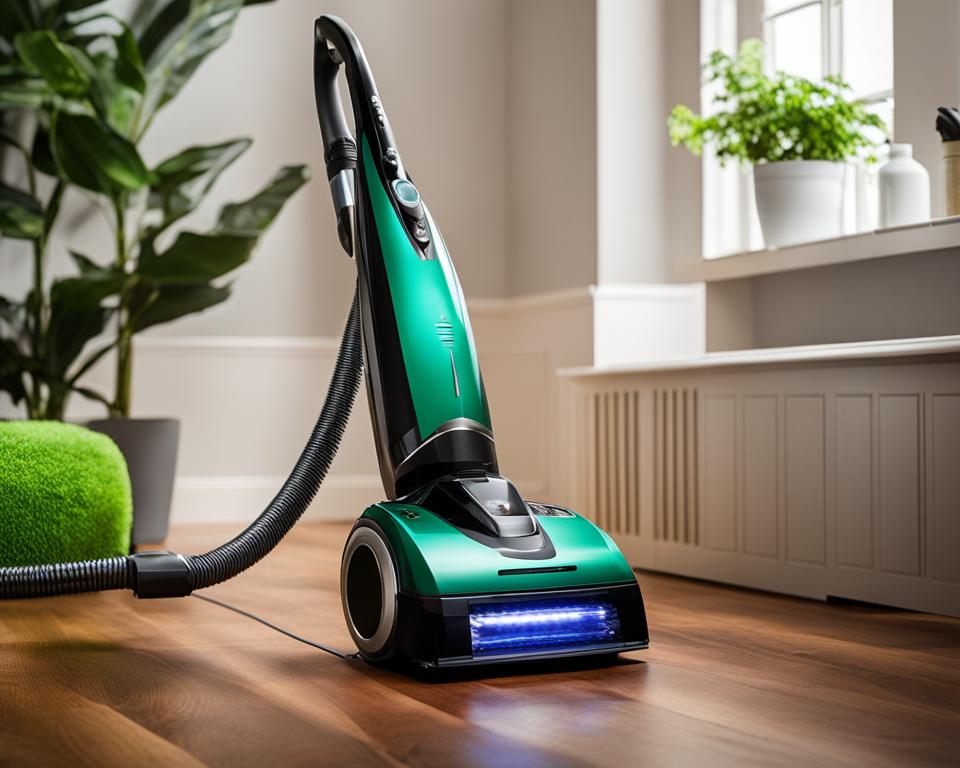When it comes to choosing a vacuum cleaner, energy efficiency is an important factor to consider. Not only does it help reduce your carbon footprint, but it also saves you money on energy bills. In this article, we will explore the energy efficiency of Shark vacuums and how they contribute to a more eco-friendly cleaning solution.
Key Takeaways
- Shark vacuums offer a wide range of designs and price points to fit different budgets.
- The Shark Stratos Cordless is the best overall energy-efficient vacuum from Shark.
- Consider factors like electricity usage, suction power, and filtration system when choosing an energy-efficient vacuum.
- The Shark NV501 Rotator Professional Lift-Away Upright Vacuum and Dyson Ball Animal 2 Upright Vacuum are top energy-efficient options.
- While robotic vacuums are energy-saving appliances, research shows they can increase overall electricity consumption.
The Best Shark Vacuums for Energy Efficiency
If you’re in the market for an energy-efficient vacuum cleaner, look no further than Shark. Known for their innovative designs and performance, Shark offers a range of models that prioritize energy efficiency without compromising on cleaning power. Whether you’re looking for a cordless option, a handheld vacuum, or even a robot vacuum, Shark has you covered.
At the top of the list is the Shark Stratos Cordless, which combines high energy efficiency with powerful suction. Equipped with the Clean Sense IQ system, this vacuum adjusts its suction power based on the amount of debris collected, ensuring optimal cleaning while saving energy. Additionally, the Shark Stratos Cordless features an odor-neutralizing system, keeping your home fresh and clean.
If you’re looking for an upper mid-range option, the Shark Cordless Pro is a great choice. With automatic power adjustment and a removable brushroll, this vacuum offers both versatility and energy efficiency. For those with mid-range budgets, the Shark Stratos UltraLight is a reliable option that comes with a replaceable odor-neutralizing cartridge.
The Best Shark Vacuums for Energy Efficiency:
| Vacuum Model | Features |
|---|---|
| Shark Stratos Cordless | Clean Sense IQ system, odor-neutralizing system |
| Shark Cordless Pro | Automatic power adjustment, removable brushroll |
| Shark Stratos UltraLight | Replaceable odor-neutralizing cartridge |
| Shark Pet Cordless | Solid performance on various surfaces |
| Shark Matrix Robot | Room mapping, self-emptying capability |
| Shark UltraCyclone Pet Pro+ | Best handheld vacuum for pet hair |
For those on a budget, the Shark Pet Cordless offers solid performance on various surfaces without breaking the bank. If you’re looking for the convenience of a robot vacuum, the Shark Matrix Robot is the top choice with its room mapping and self-emptying capability. Lastly, the Shark UltraCyclone Pet Pro+ is the ultimate handheld vacuum for pet owners, making it effortless to clean up pet hair and dander.
No matter which Shark vacuum you choose, you can be sure that you’re getting an energy-efficient and eco-friendly cleaning solution for your home.
Factors to Consider for Energy Efficiency
When selecting an energy-efficient vacuum cleaner, several important factors should be taken into consideration to ensure optimal performance and sustainability. By considering these factors, you can make an informed decision that not only saves energy but also contributes to a cleaner environment.
1. Power Consumption
The amount of electricity a vacuum cleaner consumes directly affects its energy efficiency. Opt for corded vacuums that use approximately 1200 to 1500 watts, as they strike a good balance between power and efficiency. It’s important to note that higher wattage doesn’t necessarily mean better cleaning performance, so selecting a vacuum within this range will help reduce energy consumption without compromising on effectiveness.
2. Suction Power
Efficient suction power is crucial for an effective cleaning experience. Look for vacuums that have adjustable suction settings, as this allows you to tailor the power according to different floor types and cleaning needs. By having control over the suction power, you can optimize energy usage while still achieving the desired cleanliness.
3. Filtration System
The filtration system of a vacuum cleaner not only contributes to indoor air quality but also impacts its energy efficiency. Choose bagless vacuums with washable filters, as these reduce waste generated by disposable bags while maintaining consistent suction power. Additionally, filters that are easy to access and clean ensure that the vacuum operates at peak performance, saving energy in the long run.
| Vacuum Model | Power Consumption (Watts) | Suction Power | Filtration System |
|---|---|---|---|
| Shark Stratos Cordless | 1400 | Adjustable | Washable filters |
| Shark Cordless Pro | 1300 | Automatic power adjustment | Washable filters |
| Shark Stratos UltraLight | 1200 | Adjustable | Replaceable odor-neutralizing cartridge |
| Shark Pet Cordless | 1100 | Adjustable | Washable filters |
By considering these factors and making an informed decision about your vacuum cleaner, you can contribute to a more energy-efficient and sustainable cleaning routine. Not only will this benefit the environment, but it can also lead to cost savings over time. Choosing an energy-efficient cleaning appliance is a small but significant step towards creating a greener home.
Top Energy-Efficient Vacuum Cleaners
When it comes to energy-efficient home cleaning solutions, there are several top-notch vacuum cleaners on the market that prioritize both performance and eco-consciousness. These vacuum cleaners not only provide exceptional cleaning power but also help reduce energy consumption. Let’s take a closer look at some of the best options available:
Shark NV501 Rotator Professional Lift-Away Upright Vacuum
The Shark NV501 Rotator Professional Lift-Away Upright Vacuum is a versatile and energy-efficient choice. It features a HEPA filter that captures 99.9% of dust and allergens, ensuring cleaner air in your home. With its Lift-Away technology, you can easily detach the canister to clean hard-to-reach areas. This vacuum also comes with multiple attachment tools, making it suitable for various cleaning tasks.
Miele Complete C3 Calima Canister Vacuum
The Miele Complete C3 Calima Canister Vacuum is another energy-efficient option that offers exceptional cleaning performance. Known for its quiet operation, this vacuum uses an AirClean Sealed System to ensure maximum suction power while effectively filtering out dust and allergens. The Miele Complete C3 Calima Canister Vacuum is built to last and provides a high level of durability and reliability.
Dyson Ball Animal 2 Upright Vacuum
For pet owners, the Dyson Ball Animal 2 Upright Vacuum is an excellent energy-efficient choice. This vacuum is specifically designed to handle stubborn pet hair and dander. The powerful suction and whole-machine filtration system ensure thorough cleaning, while the included pet hair tool makes removing pet hair from upholstery and carpets a breeze.
Dyson V8 Absolute Cordless Stick Vacuum Cleaner
If you prefer the convenience of a cordless vacuum, the Dyson V8 Absolute is a top-notch option. This energy-efficient vacuum cleaner offers the freedom to clean without the limitations of cords. Equipped with a HEPA filter, it effectively captures allergens and maintains excellent air quality. The Dyson V8 Absolute also provides up to 40 minutes of fade-free suction, ensuring uninterrupted cleaning.
| Vacuum | Key Features |
|---|---|
| Shark NV501 Rotator Professional Lift-Away Upright Vacuum | HEPA filter, versatile cleaning options, Lift-Away technology |
| Miele Complete C3 Calima Canister Vacuum | AirClean Sealed System, quiet operation, durable construction |
| Dyson Ball Animal 2 Upright Vacuum | Pet hair tool, powerful suction, whole-machine filtration |
| Dyson V8 Absolute Cordless Stick Vacuum Cleaner | Cordless convenience, HEPA filter, long battery life |
These energy-efficient vacuum cleaners offer exceptional performance while helping to reduce your carbon footprint. Whether you prioritize versatility, quiet operation, pet hair removal, or cordless convenience, there is a vacuum that suits your needs while minimizing energy consumption.
The Impact of Robotic Vacuums on Energy Consumption
Robotic vacuums have gained popularity in recent years for their convenience and the promise of energy efficiency. However, research suggests that the use of robovacs may actually contribute to increased energy consumption in households. While robovacs themselves consume less electricity per unit of time compared to manual vacuums, factors such as the desire for higher standards of cleanliness and the entertainment value of robovacs can lead to additional energy usage.
Households that own robovacs tend to continue using traditional vacuums for more thorough cleaning, resulting in the overall consumption of more electricity. This is because robovacs may not be able to reach all areas or effectively clean certain surfaces. Additionally, some users may have emotional attachments to their robovacs and use them frequently for entertainment purposes, further contributing to energy consumption.
It’s important to consider the impact of robotic vacuums on energy consumption and to weigh the convenience they offer against their potential environmental costs. While they may save time and effort in day-to-day cleaning, their overall energy usage should be taken into account when evaluating their energy efficiency and sustainability.

Table: Energy Usage Comparison between Robovacs and Manual Vacuums
| Robovacs | Manual Vacuums | |
|---|---|---|
| Energy Consumption | Lower per unit of time | Higher |
| Thorough Cleaning | May not reach all areas | Capable of thorough cleaning |
| Entertainment Value | May be frequently used for entertainment | N/A |
| Overall Energy Usage | May contribute to increased energy consumption | N/A |
The Hidden Costs of Smart Home Convenience

Smart Home Technologies have revolutionized the way we live, offering convenience and control at our fingertips. From automated lighting systems to voice-activated assistants, these devices are marketed as energy-efficient solutions for a more sustainable future. However, a recent study reveals that there are hidden costs associated with this convenience.
While Smart Home Technologies may reduce energy consumption in some areas, they can actually increase overall energy use inside the home. The desire for cleanliness and the emotional attachment to these devices drive their popularity, resulting in additional human effort and energy consumption. For example, homeowners may feel compelled to use robovacs for daily cleaning, only to find that they still need to use traditional vacuums for thorough cleaning.
This increased energy consumption has a significant environmental impact. The production and disposal of Smart Home devices contribute to electronic waste, which is a growing concern worldwide. Additionally, the energy used to power these devices adds to the overall carbon footprint of households.
The Environmental Costs of Smart Home Technologies
| Environmental Impact | Description |
|---|---|
| Increase in Energy Consumption | Smart Home devices can lead to increased energy usage within the home due to the desire for higher standards of cleanliness and the emotional attachment to these devices. |
| Electronic Waste | The production and disposal of Smart Home devices contribute to electronic waste, which is harmful to the environment. |
| Carbon Footprint | The energy used to power Smart Home devices adds to the overall carbon footprint of households. |
As consumers, it’s important to consider the environmental costs of Smart Home convenience and make conscious choices to minimize our impact. This can include opting for more energy-efficient devices, properly recycling old devices, and being mindful of our overall energy consumption. While Smart Home Technologies offer many benefits, it’s crucial that we weigh the hidden costs and make informed decisions to create a more sustainable future.
Tips for Energy-Efficient Vacuuming
Incorporating energy-efficient practices while vacuuming can help reduce your environmental impact and lower your energy consumption. Here are some tips to make your vacuuming routine more energy-efficient:
1. Opt for Manual Cleaning
Consider using a broom and dust mop for regular cleaning instead of relying solely on your vacuum. This can help reduce the frequency of vacuuming and minimize energy usage. Reserve your vacuum for deeper cleaning sessions.
2. Consider Repairing or Buying Second-Hand Vacuums
If your vacuum is showing signs of wear and tear, consider repairing it instead of immediately purchasing a new one. Additionally, buying second-hand vacuums can be a cost-effective and eco-friendly alternative. Look for well-maintained models with energy-efficient features.
3. Keep Canisters or Bags Empty and Filters Clean
Emptying the canister or bag of your vacuum regularly and keeping the filters clean can contribute to better suction power and energy efficiency. When the canister or bag is full, the vacuum has to work harder, using more energy to pick up dirt and debris. Clean filters also allow for better airflow, reducing strain on the vacuum motor.
4. Improve Indoor Air Quality with HEPA Filters
Consider investing in a vacuum with a High-Efficiency Particulate Air (HEPA) filter. HEPA filters trap microscopic allergens and pollutants, improving indoor air quality. By capturing more particles, your vacuum won’t need to work as hard, leading to energy savings.
By implementing these energy-efficient vacuuming practices, you can reduce your vacuum’s energy footprint while maintaining a clean and healthy living environment.
FAQ
How energy efficient are Shark vacuums?
Shark offers a wide range of vacuum designs including robot vacuums, handheld configurations, and corded and cordless models. While they don’t explicitly disclose their energy efficiency ratings, they strive to provide efficient performance without compromising suction power. Their vacuums are designed with features like automatic power adjustment and Clean Sense IQ system to optimize energy usage based on debris collected.
Which Shark vacuum is the most energy efficient?
The Shark Stratos Cordless is considered the best overall energy-efficient vacuum from Shark. It features the Clean Sense IQ system, which adjusts suction power based on debris collected, and has an odor-neutralizing system. Other energy-efficient options include the Shark Cordless Pro, Shark Stratos UltraLight, and Shark Pet Cordless.
What factors should I consider for energy efficiency in a vacuum cleaner?
When choosing an energy-efficient vacuum, important factors to consider include the amount of electricity it uses, its suction power, and its filtration system. Corded vacuums that use between 1200 and 1500 watts are recommended for a balance of efficiency and power. Bagless options with washable filters can reduce waste and maintain suction power.
What are the top energy-efficient vacuum cleaners?
Some of the top energy-efficient vacuum cleaners in the market include the Shark NV501 Rotator Professional Lift-Away Upright Vacuum, Miele Complete C3 Calima Canister Vacuum, Dyson Ball Animal 2 Upright Vacuum, and Dyson V8 Absolute Cordless Stick Vacuum Cleaner. These models offer a combination of energy efficiency, powerful suction, and advanced features like HEPA filters and multiple attachment tools.
Do robotic vacuums consume less energy compared to manual vacuums?
While robotic vacuums are advertised as energy-saving appliances, research suggests that households with robovacs actually consume more electricity overall. While robovacs use less electricity per unit of time compared to manual vacuums, most owners continue to use traditional vacuums for thorough cleaning. The desire for higher standards of cleanliness and the entertainment value of robovacs contribute to increased energy consumption.
What are the hidden costs of smart home convenience in terms of energy consumption?
Smart Home Technologies like robovacs are marketed as energy-efficient, but studies reveal that they can actually increase energy use inside the home. The desire for cleanliness and emotional attachment to these devices drive their popularity, resulting in additional human effort and overall energy consumption. It’s important to consider the environmental costs of Smart Home convenience.
How can I make vacuuming more energy-efficient?
To reduce the energy footprint of vacuuming, consider using a broom and dust mop for regular cleaning, repairing or buying second-hand vacuums, and keeping the canister or bag empty and filters clean. Leaving shoes at the door can minimize dirt brought into the home, while choosing a vacuum with a High-Efficiency Particulate Air (HEPA) filter can improve indoor air quality.

Leave a Reply